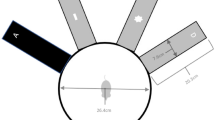Abstract
The study of food repulsion in ungulates is of practical importance for controlling browsing damage to forest trees and agricultural crops. Experiments with domestic sheep assessed the repulsive value of three natural and two synthetic products, using a food-choice situation. Animals were individually presented with two troughs, each containing 30 g of maize, one treated with a chemical product, and the other a control. The odor of domestic dog feces appeared to be highly repulsive, as none of the treated food was eaten, whereas 3 g ±9 and 6 g ±10 were eaten, respectively, of food treated with fetal fluids from sheep and odor of pig feces. Synthetic odors of lion feces and a commercial deer repellent were less efficient as repellents with 11 g ±13 and 14 g ±15 of food eaten, respectively. Habituation to three of the repellents was tested for a minimum of seven successive days. With dog feces, no habituation to the odor was observed. On the contrary, significant habituation (P < 0.05) was observed as early as the third trial for sheep fetal fluids and the fourth trial for the commercial repellent. To test for the effects of social facilitation, groups of four sheep including no, one, or two anosmic animals were presented with food treated with the odor of dog feces. No social facilitation was observed as none of the intact sheep ate any of the food, although the anosmic animals actively ate it throughout the test. In individual food choice tests, the odor of dog feces appeared to be an especially efficient repellent when compared with the other natural or synthetic products. Such repulsion was nearly complete, and neither habituation nor social facilitation could be observed.
Similar content being viewed by others
References
Abbott, D.H., Baines, D.A., Faulkes, C.G., Lewis, E., Ning, P.C.Y.K., andTomlimson, A.J. 1990. A natural deer repellent: Chemistry and behaviour, pp. 599–609,in D.W. Macdonald, D. Müller-Schwarze, and S.E. Natynczuk (eds.). Chemical Signals in Vertebrates 5. Oxford University Press, Oxford.
Albone, E.S., andFox, M.W. 1971. Anal gland secretion of the red fox.Nature 233:569–566.
Arnould, C., Piketty, V., andLévy, F. 1991. Behaviour of ewes at parturition toward amniotic fluids from sheep, cows and goats.Appl. Anim. Behav. Sci. 32:191–196.
Chapple, R.S., Wodzicka-Tomaszewska, M., andLynch, J.J. 1987a. The learning behaviour of sheep when introduced to wheat. I. Wheat acceptance by sheep and the effect of trough familiarity.Appl. Anim. Behav. Sci. 18:157–162.
Chapple, R.S., Wodzicka-Tomaszewska, M., andLynch, J.J. 1987b. The learning behaviour of sheep when introduced to wheat. II. Social transmission of wheat feeding and the role of the senses.Appl. Anim. Behav. Sci. 18:157–162.
Gorman, M.L. 1984. The response of prey to Stoat (Mustela erminea) scent.J. Zool. London 202:419–423.
Harris, M.T., Palmer, W.L., andGeorge, J.L. 1983. Preliminary screening of white-tailed deer repellents.J. Wildl. Manage. 47:516–519.
Lévy, F., Poindron, P., andLe Neindre, P. 1983. Attraction and repulsion by amniotic fluids and their olfactory control in the ewe around parturition.Physiol. Behav. 31:687–692.
Melchiors, A., andLeslie, C.A. 1985. Effectiveness of predator fecal odors as black-tailed deer repellents.J. Wildl. Manage. 49:358–362.
Müller-Schwarze, D. 1972. Responses of young black-tailed deer to predator odors.J. Mammal. 53:393–394.
Oita, K.,Oh, J.H., andTiedeman, G.T. 1976. Wildlife damage control I: Development of deer repellents. 172nd National Meeting of the American Chemical Society, San Francisco. Abstract No. 67.
Pfister, J.A., Müller-Schwarze, D., andBalph, D.F. 1990. Effects of predator fecal odors on feed selection by sheep and cattle.J. Chem. Ecol. 16:573–583.
Poindron, P. 1974. Méthode de suppression réversible de l'odorat chez la brebis et vérification de l'anosmie au moyen d'une épreuve comportementale.Ann. Biol. Anim. Biochim. Biophys. 14:411–415.
Sullivan, T.P., andCrump, D.R. 1984. Influence of mustelid scent-gland compounds on suppression of feeding by snowshoe hares (Lepus americanus).J. Chem. Ecol. 12:1809–1821.
Sullivan, T.P., Nordstrom, L.O., andSullivan, D.S. 1985a. Use of predator odors as repellents to reduce feeding damage by herbivores. I. Snowshoe hares (Lepus americanus).J. Chem. Ecol. 11:903–919.
Sullivan, T.P., Nordstrom, L.O., andSullivan, D.S. 1985b. Use of predator odors as repellents to reduce feeding damage by herbivores. II. Black-tailed deer (Odocoileus hemionus columbianus).J. Chem. Ecol. 11:921–935.
Sullivan, T.P., Crump, D.R., andSullivan, D.S. 1988a. Use of predator odors as repellents to reduce feeding damage by herbivores. III. Montane and meadow voles (Microtus montanus andMicrotus pennsylvanicus).J. Chem. Ecol. 14:363–377.
Sullivan, T.P., Sullivan, D.S., Crump, D.R., Weiser, H., andDixon, E.A. 1988b. Predator odors and their potential role in managing pest rodents and rabbits.Proc. Vertebr. Pest Conf. 13:145–150.
Swihart, R.K., Pignatello, J.J., andMattina, MJ.I. 1991. Aversive responses of white-tailed deer,Odocoileus virginianus, to predator urines.J. Chem. Ecol. 17:767–777.
Van Haaften, J.L. 1963. A natural repellent, pp. 389–392,in International Union of Game Biologists, Transactions VI Congress, 7–12 October. The Nature Conservancy, London.
Vernet-Maury, E. 1980. Trimethyl-thiazoline in fox feces: A natural alarming substance for the rat, p. 407,in H. van der Starre (ed.). Proceeding of the VII International Symposium on Olfaction and Taste VII.
Vernet-Maury, E., Le Magnen, J., andChanel, J. 1968. Comportement emotif chez le rat; influence de l'odeur d'un predateur et d'un non-prédateur. C.R. Acad. Sci. Paris (Ser. D). 267:331–334.
Vernet-Maury, E., Polak, E.H., andDemael, A. 1984. Structure-activity relationships of stressinducing odorants in the rat.J. Chem. Ecol. 10:1007–1018.
Author information
Authors and Affiliations
Rights and permissions
About this article
Cite this article
Arnould, C., Signoret, J.P. Sheep food repellents: Efficacy of various products, habituation, and social facilitation. J Chem Ecol 19, 225–236 (1993). https://doi.org/10.1007/BF00993691
Received:
Accepted:
Issue Date:
DOI: https://doi.org/10.1007/BF00993691




